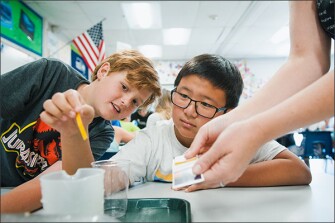
Sometimes showing is easier than telling. That’s certainly the case in trying to capture the Next Generation Science Standards—the K-12 learning benchmarks that 18 states and the District of Columbia have adopted and are now using in classrooms.
Unlike some previous science standards that focused on the facts, these standards emphasize action. They ask students to construct models, interpret data, design structures, and make arguments.
As part of a recent special report on assessment, I wrote a story about where states stand with their NGSS-aligned tests. To give readers a taste of what the science standards look like in the classroom, we sent photographer Andrew Cullen out to Manhattan Beach, Calif., to snap some photos for the story.
The photos are vibrant—and really seize on the hands-on, action-oriented nature of the standards.

In them, Joanne Michael, the K-5 science specialist at Meadows Elementary School, takes her students through an exploration of water filtration, using space as a setting.
“We talk about how there’s what scientists call gray water—it’s not necessarily toxic but it’s dirty water,” she explained in an interview after the photo shoot. “On the International Space Station, it’s amazingly expensive to transport anything, so they’re not going to bring in huge amounts of clean water.” Astronauts use a water filtration system to purify their wastewater so that they can eventually drink it, Michael tells the class.
The 5th grade students are tasked with designing a filter of their own to turn “gray water” (dirtied with salad dressing) into water with a drinkable pH.
Students use one-liter water bottles to build a filtration device and litmus strips to test the water. They are given an imaginary budget with which to purchase supplies, such as coffee filters, sand, marbles, and cotton balls.
“A lot of it is trial and error,” Michael said. “I try to guide but not lead. .... [I ask], ‘Are you going to want to put stuff that really absorbs at the top or on the bottom?’”
Each student draws a model of what they think might work, and discusses it with their team before they begin building.

Michael uses the lesson to talk about atmospheric conditions and ways to conserve natural resources. The class discusses, “where does water come from?” she said. “For us, it rains. Well, it doesn’t rain in space so how are they going to get their water?” Michael also brings in math concepts with the budget.
“I do [the lesson] with 5th grade,” said Michael. “You can probably modify it down to 3rd grade. I’ve seen college students doing it.”
Michael says she’s been doing hands-on lessons like this one for many years, but that the Next Generation Science Standards’ emphasis on doing has been validating.
“It’s no longer read this book, take this test, move on with your day,” she said. “They’re actually getting into science, actually doing science. ... I absolutely adore that.”
See also: Next-Generation Science Tests Slowly Take Shape
Images:
(Top) Fifth graders Brayden Titus and William Cui test the pH level of tap water during a science lab to devise and test water filtering materials at Meadows Elementary School in Manhattan Beach, Calif.
(Middle) Fifth graders Christopher Halkias and Jace Cortez watch to see how well the filter system they devised separates water from salad dressing.
(Bottom) Fifth grader Nyna Manabe, left, her teacher Joanne Michael, center, and classmates Clara Soricut, Grant Gilmer, and Carley Kubler, left to right, watch to see how the water filter they created works. —Andrew Cullen for Education Week
